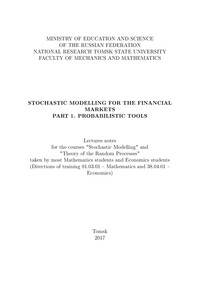Stochastic modelling for the financial markets. Part 1. Probabilistic tools
Покупка
Издательство:
Томский государственный университет
Год издания: 2017
Кол-во страниц: 46
Дополнительно
The main goal of these lectures notes is to give the basic notions of the stochastic calculus such that conditional expectations, predictable processes, martingales, stochastic integrals and Ito's formula. The notes are intended for students of the Mathematics and Economical Faculties. This work was supported by the Ministry of Education and Science of the Russian Federation (Goszadanie No 1.472.2016 FPM).
Тематика:
ББК:
УДК:
ОКСО:
- ВО - Бакалавриат
- 01.03.01: Математика
- ВО - Магистратура
- 38.04.01: Экономика
ГРНТИ:
Скопировать запись
Фрагмент текстового слоя документа размещен для индексирующих роботов
MINISTRY OF EDUCATION AND SCIENCE OF THE RUSSIAN FEDERATION NATIONAL RESEARCH TOMSK STATE UNIVERSITY FACULTY OF MECHANICS AND MATHEMATICS STOCHASTIC MODELLING FOR THE FINANCIAL MARKETS PART 1. PROBABILISTIC TOOLS Lectures notes for the courses "Stochastic Modelling" and "Theory of the Random Processes" taken by most Mathematics students and Economics students (Directions of training 01.03.01 - Mathematics and 38.04.01 Economics) Tomsk 2017
APPROVED the Department of Mathematical Analysis
Head of the Department, Associate Professor L.S. Kopaneva
REVIEWED and APPROVED Methodical Commission of
the Faculty of Mechanics and Mathematics
Minutes No from ”” Febrary 2017
Chairman of the Commission, Associate Professor O.P. Fedorova
The main goal of these lectures notes is to give the basic notions of the stochastic calculus such that conditional expectations, predictable processes, martingales, stochastic integrals and Ito’s formula. The notes are intended for students of the Mathematics and Economical Faculties.
This work was supported by the Ministry of Education and Science of the Russian Federation (Goszadanie No 1.172.2016 FPM).
AUTHORS
Professor Serguei M. Pergamenshchikov and Associate Professor
Evgeny A. Pchelintsev
© Tomsk State University, 2017
Contents
1 Introduction 4
1.1 Probability space............................... 4
1.2 Random variables, vectors and mappings ......... 6
1.3 Conditional expectations and conditional probabilities 7
1.4 Stochastic basis............................... 13
2 Markovian moments 15
3 Stochastic processes 19
4 Optional and Predictable a - fields 21
5 Martingales 27
6 Stochastic integral 32
7 Appendix 38
7.1 Caratlieodory’s extension theorem ............. 38
7.2 Radon - Nikodym theorem ....................... 40
7.3 Kolmogorov theorem............................. 41
References 44
3
Introduction
1.1 Probability space
Definition 1.1. The measurable space (Q, F, P) is called the probability space, where Q is any fixed universal Ft, F isc- field and P is a probability measure.
It should be noted that if the set Q is finite or countable then the field (or a - field) F is defined as all subsets of the set Q, i.e. F = {A : A C Q}. Moreover, in this case the probability is defined as
P(A) = X P(M), (1.1)
weA
where P({w}) is defined for every ш from Q.
Examples
1. The Bernoulli space.
The set Q = {0,1} and F = {Q , 0, {0} , {1}}- The probability is defined as P({0}) = p and P({1}) = 1 — p for some fixed 0 < p < 1. Note that, if p = 1/2, then we obtain the "throw a coin" model.
4
2. The binomial space.
The set Q = {0,1,..., n} and F = {A : A C Q}. In this case for any 0 < k < n the probability is defined as
P({k}) =
pk (1 - p)ra⁻fc
(1-2)
3. The finite power of the Bernoulli spaces.
The set Q = {0,1}ⁿ = {wl},. l. ₂- . where wl a re n-dimensional vectors, i.e. wl = (wz>₁,..., wl,ₙ) a nd wlj- e {0,1}. The field F = {A : A C Q} and
P(wl)= pv (1 - p)ⁿ⁻v , (1.3)
where vl = Pn₌₁ ш^.
4. The infinite power of the Bernoulli spaces.
The set Q = {0,1}^ = {w}. In th is case w = (wl )z>₁, wl e {0,1} and the set Q is note countable, moreover, this set is isomorphes to interval [0,1] by the natural representation
x = £ wl 2⁻z e [0,1]. l>1
(1-4)
5


